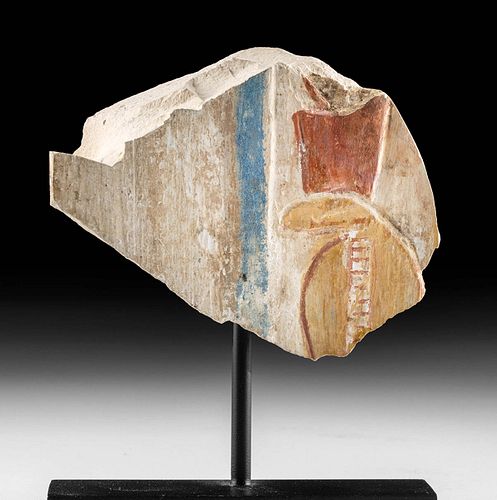Egyptian Polychrome Stone Relief Fragment of Uraeus
Lot 19a
About Seller
Artemis Fine Arts
686 S Taylor Ave, Ste 106
Louisville, CO 80027
United States
Selling antiquities, ancient and ethnographic art online since 1993, Artemis Gallery specializes in Classical Antiquities (Egyptian, Greek, Roman, Near Eastern), Asian, Pre-Columbian, African / Tribal / Oceanographic art. Our extensive inventory includes pottery, stone, metal, wood, glass and textil...Read more
Categories
Estimate:
$2,400 - $3,600
Absentee vs Live bid
Two ways to bid:
- Leave a max absentee bid and the platform will bid on your behalf up to your maximum bid during the live auction.
- Bid live during the auction and your bids will be submitted real-time to the auctioneer.
Bid Increments
| Price | Bid Increment |
|---|---|
| $0 | $25 |
| $300 | $50 |
| $1,000 | $100 |
| $2,000 | $250 |
| $5,000 | $500 |
| $10,000 | $1,000 |
| $20,000 | $2,500 |
| $50,000 | $5,000 |
| $100,000 | $10,000 |
| $200,000 | $20,000 |
About Auction
By Artemis Fine Arts
Jun 10, 2021
Set Reminder
2021-06-10 10:00:00
2021-06-10 10:00:00
America/New_York
Bidsquare
Bidsquare : Exceptional Antiquities | Asian | Ethnographic
https://www.bidsquare.com/auctions/artemis-gallery/exceptional-antiquities-asian-ethnographic-7012
Museum-worthy examples of Egyptian, Greek, Roman, Viking, Near Eastern, Far East / Asian, Pre-Columbian, African / Tribal, Oceanic, Native American, Spanish Colonial, Russian, Fossils, Ancient Jewelry, Fine Art, so much more! Artemis Fine Arts info@artemisgallery.com
Museum-worthy examples of Egyptian, Greek, Roman, Viking, Near Eastern, Far East / Asian, Pre-Columbian, African / Tribal, Oceanic, Native American, Spanish Colonial, Russian, Fossils, Ancient Jewelry, Fine Art, so much more! Artemis Fine Arts info@artemisgallery.com
- Lot Description
Egypt, Late Dynastic Period, 26th to 31st Dynasty, ca. 664 to 332 BCE. An impressive stone relief depicting a uraeus wearing the red crown of Lower (Northern) Egypt, known as the Deshret, adorned in vibrant hues of sky blue, burnt sienna, yellow ochre, light brown, and white. The uraeus was a sacred cobra worn on the headdresses of Egyptian deities and sovereigns. The remarkable piece displays the ancient serpent with an ovoid head and flared hood facing a thick vertical striation of blue pigment. A central white stripe with several horizontal lines decorates the cobra's body. The inclusion of the Deshret upon the head of the uraeus in this example indicates that the serpent was likely intended as a representation of goddess Wadjet, who was the matron and protector of Lower Egypt and, upon unification with Upper Egypt, the joint protector of all of Egypt. When Wadjet is shown in the form of a cobra, she serves the role of patron and protector, hence why the symbol of the uraeus is used on the crowns of Lower and unified Egypt; to emphasize her protection over the pharaoh who sought to rule her land. Size: 3.125" L x 1.5" W x 2.625" H (7.9 cm x 3.8 cm x 6.7 cm); 3.875" H (9.8 cm) on included custom stand.
Wadjet's counterpart is Nekhbet, the tutelary deity of Upper Egypt who appeared as a vulture. When Egypt was unified, the image of Nekhbet joined Wadjet on the uraeus. Together, the deities were known as the Nebty or the "Two Ladies" who were joint patrons and protectors of Egypt and worshipped by all. Unlike many other deities of Ancient Egypt, the Two Ladies were not merged with other gods and retained their identities as distinct goddesses due to each of their importance to their separate cults.
The carved (rather than simply painted) and brightly colorful nature of this relief indicates that it was from a prestigious location - most likely a major temple, but also possibly a high-ranking official's tomb or even a palace. Images like this one were part of larger stories, usually a journey through the afterlife or meeting deities in the afterlife, that were designed to help people understand religious concepts and, if found in a tomb, to introduce the dead to their new world.
Provenance: private collection, Santa Clara, California, USA, acquired prior to 2010
All items legal to buy/sell under U.S. Statute covering cultural patrimony Code 2600, CHAPTER 14, and are guaranteed to be as described or your money back.
A Certificate of Authenticity will accompany all winning bids.
We ship worldwide and handle all shipping in-house for your convenience.
#164638Fragment of larger piece. Expected light abrasions. Otherwise, excellent with impressive remaining pigments.Condition
- Shipping Info
-
All shipping is handled in-house for your convenience. Your invoice from Artemis Gallery will include shipping calculation instructions. If in doubt, please inquire BEFORE bidding for estimated shipping costs for individual items.
-
- Buyer's Premium



 EUR
EUR CAD
CAD AUD
AUD GBP
GBP MXN
MXN HKD
HKD CNY
CNY MYR
MYR SEK
SEK SGD
SGD CHF
CHF THB
THB













